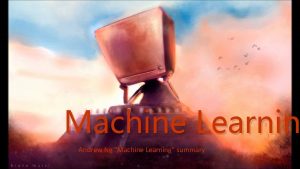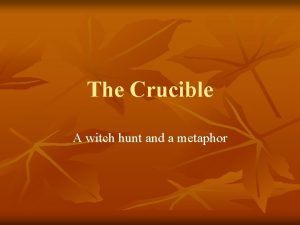LEARNIN Scavenger hunts for gamified spatial G SCENARI


- Slides: 2

LEARNIN Scavenger hunts for gamified spatial G SCENARI learning O Educational level: Secondary | Age: 10 -18 Author: Bart Verswijvel, European Schoolnet LEARNING OBJECTIVES/ ASPIRATIONS Scavenger hunts for gamified spatial learning makes learning dynamic. Students explore and use the environment and are immersed in a holistic learning experience that includes a wide range of activities. Making use of mobile learning, the activity focuses on responsibility, ownership, creativity and group work. NARRATIVE OVERVIEW Learning should be a discovery for students. Reading-based activities can certainly have the effect of a mental discovery. Students could also physically go on a learning journey and find or walk to destinations, either in the class or school building, or even better, outside the school. Together with mobile technologies, the experience of being an explorer could even be made stronger this way. Scavenger hunts are games, typically played in an outdoor area, where participants have to find a number of hidden objects. Geocaching is a similar activity, in which participants use a mobile device and other navigational techniques to hide and seek containers, called geocaches or caches, at specific locations marked by coordinates. Both traditional scavenger hunts and geocaching are used in the context of education, but if the only objective is to find objects, the activity is in a way limited. Nowadays teachers can make use of several applications to combine spatial learning with game elements and tools like GPS locations, directions, maps, QR codes, pictures, videos, quizzes, missions, tournaments, etc. The application on the device of the students leads the learners to tasks located in different spaces. The typical gamification elements and techniques are added to the experience, like scores, challenges and immediate feedback. Scavenger hunts for gamified spatial learning combine many pedagogical approaches into one activity. In most cases spatial scavenger hunts are small group activities. The teams move to different stops or stations and are challenged in diverse ways. APPROACH TO TEACHING AND LEARNING After the completion of a project, or during the drafting phase, seek the insight of an expert to build on what students have learned and make a meaningful connection to the community. Practice writing emails, reaching out to the experts, organize a meeting, and prepare valuable questions for the expert. ASSESSMENT For the specific learning objectives, preparing the questions for the expert is an excellent opportunity for the teacher to evaluate what learning goals are concrete and which ones are not. With groups creating a list of questions they need to know the answers to and choosing the most important ones - the class reviews important information. ROLES TEACHERS: Preparing a scavenger hunt activity which includes free movements of students, is complex and can be time consuming. The role of the teacher is to consider all aspects of the activity and have plan B ready. Teachers must give clear instructions to students before the start and organize feedback and assessment after the activity. If scavenger hunts take place outdoors, the safety of the students is a priority. LEARNERS: The learners get some freedom of movement to overcome the challenges of the scavenger hunt. By creating the task, the teacher decides on the actual activities. In most cases the learners work in small teams.

Scavenger hunts for gamified spatial learning LEARNING ACTIVITIES LEARNING ENVIRONMENT • The idea of the scavenger hunt definitely supports the idea of the dynamic classroom. The learners move around the classroom, school building or outdoors and the space can play the role of the third teacher. • The pedagogical concepts behind the learning zones can be connected to the scavenger hunt. The tasks can include multiple investigation and creation activities. At the end, the different participants can, either individual or in group, present in plenary what they created or learned from the scavenger hunt activity. • Before and after the scavenger hunt, the teacher interacts with the students to brief and debrief. During the scavenger hunts the students work in groups and exchange. In fact, scavenger hunts take place without the direct supervision of the teacher, so the learners develop their learning independently. • Scavenger hunts can be used as an alternative for more traditional station rotation activities. The scavenger hunt could be set up so that students can go to a free space, either in groups or individually, and perform the task. • Scavenger hunts can be used to give students controlled independence to explore the area when going on a school trip. • QR codes are often used as access points to the necessary information on each of the stages of the scavenger hunt. Also, students can create tours or scavenger hunts for peers by means of QR codes. • If spatial movements are not feasible, scavenger hunts can take place virtually. Students need to find clues to hop from one place on the internet to another one and eventually arrive at the final destination. LITERATURE TO SUPPORT POSSIBLE CHALLENGES Giving students the freedom to walk around, especially in areas where the teacher cannot supervise all the students, requires confidence. Moving from a traditional teacher-centred context where teachers have full control on their students requires a different mindset. It is important to shift gradually from traditional teaching with fixed classroom lay-outs to spatial learning. Classroom management will be different. Also, safety of students is an issue to bear in mind. Hall, S. (2019, 8 13). Engaging Students with Scavenger Hunts. Retrieved from Teachers First: https: //teachersfirst. com/blog/2019/08/engagingstudents-with-scavenger-hunts/ Marie. (2020, 3 31). Creating a Scavenger Hunt for Your Classroom. Retrieved from Perfecting the World of Middle School Literature: https: //completeliterature. com/creating-a-scavengerhunt-for-your-classroom/ RESOURCES • Action Bound - https: //actionbound. com/ • Locatify - https: //locatify. com/ LEARNING SCENARIO VIDEO https: //www. youtube. com/watch? v=Yxs. Srx 0 Np. ZM The learning scenario is created by the Design. FILS project ( http: //designfils. eba. gov. tr), funded by EU’s Erasmus+ KA 2 (grant agreement 2019 -1 -TR 01 -KA 201 -076567). The contents of the publication are the sole responsibility of the authors, and the EC or Turkish National Agency cannot be held responsible for any use which may be made of the information contained therein. The publication is made available under the terms of Creative Commons License Attribution–Non-Commercial (CC-BY-NC).



